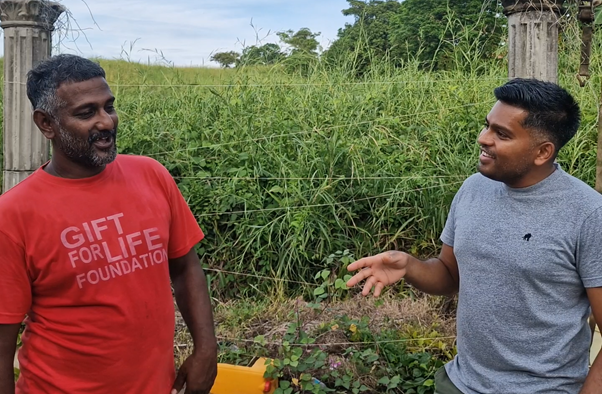The Scorpion chilli pepper (Capsicum chinense) with its various manifestations including the Trinidad Moruga Scorpion, Trinidad Scorpion and the Butch T Scorpion to name a few, is perhaps the one chilli variety with the most mysterious origins. Over the years, many people have tried to untangle the history of the Scorpion pepper, but there still remains an air of mystery surrounding who actually bred the very first Scorpion pepper, and whether it started off as a Trinidad Scorpion or a Trinidad Moruga Scorpion.
Since taking over the South Devon Chilli Farm, I have spent a lot of time trying to untangle this history, particularly from the perspective of the Trinidad Moruga Scorpion (as it is a name and a place very close to my heart). Despite having very similar names, this, and the Trinidad Scorpion, are two different cultivars. Note, I use the word ‘chilli’ and ‘pepper’ interchangeably since this is how we would use them in Trinidad, with more emphasis on ‘pepper’.
There have been a few attempts to catalogue the Scorpion’s history, perhaps the most thorough documentation to date has been done by The League of Fire and published in their article “The Trinidad, The Moruga & The Scorpion” (https://leagueoffire.com/the-trinidad-the-moruga-the-scorpion/). Their article goes into a lot of detail such as comparing fruit morphology, and they point out many of the issues with the timeline surrounding the Scorpion pepper and which version came first. This blog isn’t an attempt to critique their article and conclusions – it is simply another take based on my own research. But I would urge anyone interested in knowing the history of these peppers to read their article as well, since they present a lot of information that would otherwise be disparate and scattered which further showcases how unclear the true origins of the peppers are.
With all of this controversy, I decided to make a pilgrimage to Moruga, Trinidad, to try and find some clarity. So, in November 2024, I travelled back to Trinidad and enlisted the help of my family who still live in Moruga to track down the person who they believe is the original creator of the Moruga Scorpion.
Since gaining the title of the hottest chilli in the world in 2012, there has been virtually no mention in the media about the creator of the original Moruga Scorpion. The only reference I can find is a Wikipedia article (Figure 1 https://en.wikipedia.org/wiki/Trinidad_Moruga_scorpion) which claims that a person by the name of Wahid Ogeer of Trinidad is the creator of the yellow cultivar of the Trinidad Moruga Scorpion.
This mention of ‘yellow cultivar’ is important, since the consensus amongst the chilli growing community is that the original Trinidad Moruga Scorpion was red. Indeed, many of the super-hot chillies started off as red cultivars and have subsequently been selected for different colour phenotypes. So, who created the original red Trinidad Moruga Scorpion?
In my opinion, the article almost implies that Mr. Ogeer is the creator of the original Moruga Scorpion and that it happened to be yellow. This inconsistency in the language used in the Wikipedia article isn’t just an issue of semantics, since botanically any subsequent phenotypes from later generations of cross breeding would naturally be called a ‘cultivar.’ Add to this the fact that the Wikipedia article also has a picture of the archetypal red Moruga Scorpion juxtaposed against the author’s claims that Mr Ogeer created it.
Given the prominence of the Scorpion peppers globally, one would expect there to be more than just one or two cursory articles in the Trinidad Guardian about the creator of these infamous peppers. Was it just poor journalism at the time to have missed this opportunity to give proper recognition to a local who created something that became world famous? Or could it be that the editors at the time were just as confused as we are today? I can’t get hold of the original Trinidad Guardian article, but there has been later references by the newspaper of that original photo of Mr Ogeer (https://www.facebook.com/photo.php?fbid=10153406871248067&id=78081948066&set=a.87957863066).
I have always been skeptical about whether Wahid Ogeer was the creator of the original red Trinidad Moruga Scorpion. According to the very sparse public information, Mr Wahid operates a farm in Chickland Caparo Road in Freeport (according to articles published in the Trinidad and Tobago Guardian around the time when the Scorpion pepper started gaining notoriety in the media). Chickland, Freeport is in a completely different part of the country and is not anywhere near the village of Moruga (Figure 2).

Figure 1. Wikipedia article on the Trinidad Moruga Scorpion. https://en.wikipedia.org/wiki/Trinidad_Moruga_scorpion. [Accessed 12/02/2025].

Figure 2. Map of Trinidad showing the location of Chickland, Freeport and Moruga.
Moruga is located on the southern coast of Trinidad and has a long history of farming. The most notable area is called ‘Lassavan’, a remote, rural area comprising many small farms (Figure 3) located east off the Moruga Road down La Fortune Trace (Figure 4). If you were to look for this Lassavan area on a map, you wouldn’t see many, if any at all mention of it. It seems to be a term that isn’t officially recognized. But locals know and use it to refer to this particular farming area in Moruga. Lassavan is well known amongst the locals to be the farming heartland of Moruga and has been this way for generations.

Figure 3. Location of Lassavan, Moruga.

Figure 4. Sign post at the junction of Moruga Road and La Fortune Trace.
Luckily for me, I still have family connections in the area and some extended family and friends who still farm in the area. I was fortunate enough to meet one of the elders of the village, a gentleman who has been farming in Lassavan all his life. He preferred to remain unnamed, but without his help, I would not have been able to track down the person whom he believes to be the creator of the Trinidad Moruga Scorpion. After introducing myself and having a chat about my family origins and connections to the area, he agreed to escort us to the family home of local farmer Mr. Nigel Rooplal.
Nigel was a humble farmer and was generous enough to spare some of his time to talk to me and introduce me to his family. According to Nigel, the true Trinidad Moruga Scorpion was created by himself and his brother, Russell Rooplal (a.k.a Rocky) in the years leading up to 2010. Sadly, Russell died a few years ago, and according to Nigel, he was the ‘brains behind their crossbreeding program’. Nigel was kind enough to give me a brief video interview (you can check out the video on our Youtube channel). He had just come home after a long day of farming, so I was delighted to be able to get a chance to speak to him. Nigel told the story of him and his brother setting out to create a very hot pepper. And that they managed to create the Moruga Scorpion by cross breeding a Trinidad 7-Pot and Congo Pepper. The commercial demand for super-hot chillies in Trinidad was driven by the local appetite for hotter and hotter chillies, especially for the popular street food called ‘doubles’. The 7-Pot has been known to be an extremely hot pepper for many years. The 7-Pot and the Congo Pepper are both landrace varieties (i.e., local traditional cultivars). The term ‘Congo Pepper’ is a name used locally in Trinidad to refer to red or yellow Habanero-type peppers. Nigel said that they released their Moruga Scorpion pepper in 2010.
Nigel said that he and his brother didn’t get any help locally from the Ministry of Agriculture to formally recognize their achievement. And their names were never mentioned anywhere. It seems that they simply got forgotten about or maybe even intentionally left out of the story of this infamous pepper.
Nigel also told me that over the last few years, and even as recently as a few weeks prior to my trip, he had another person visit him in Lassavan from England trying to track down the origins of the Trinidad Moruga Scorpion pepper. It just shows that there are people out there, like me, who aren’t convinced by the sparsely documented history of this infamous pepper.
To add a bit more complication to this Scorpion saga, according to an article published in June 2011 in UWI Today (https://sta.uwi.edu/uwitoday/archive/june_2011/article1.asp), the editor, Vaneisa Baksh, talks about how Trinidad never got the necessary credit and recognition for the provenance of the controversial Butch T Scorpion which was crowned hottest chilli in the world in 2011, a year before the Trinidad Moruga Scorpion took the title. The order of words to describe this cultivar varies from author to author. It is worth mentioning this Trinidad Scorpion Butch T pepper (https://en.wikipedia.org/wiki/Trinidad_Scorpion_Butch_T_pepper), since there are issues with the time line for the emergence of these cultivars as the League of Fire mentioned in their article. Interestingly, Vanesia mentions that ‘Scorpion’ peppers were being tested for their extreme heat levels as far back as 1998 when PhD researchers at the University of the West Indies were conducting research into the peppers and measuring their heat levels. According to Vanesia, Scorpion peppers were grown by a farmer (Lawrence Constantine) in Maracas in the north of Trinidad as far back as 1998 or even earlier. These were certainly not Moruga Scorpion peppers, but they were almost certainly some type of super-hot pepper that would be very similar to many Scorpions that have emerged since then. It is also unclear when the term ‘Scorpion’ was first used to describe these extremely hot peppers. The name is believed to have been introduced to describe the tail of the pepper which resembles the stinger of a scorpion. But no one knows who exactly coined the term ‘Scorpion.’
Since the Trinidad 7-Pot (a.k.a. 7-Pod) is a landrace variety widely grown in Trinidad for many years, it is quite possible that, Nigel and Russel through their cross-breeding efforts in Moruga intentionally struck upon a similarly hot variety to the ‘Scorpion’ peppers which were grown in the north of Trinidad by Mr. Constantine and tested by PhD researchers in the 1990s. And Nigel’s and Russel’s cultivar became the Moruga Scorpion due to their provenance in Lassavan, Moruga. While speaking to Nigel, he told me definitively that he and his brother chose the name Moruga Scorpion when they released the pepper. This would make sense etymologically.
Without genetic testing, which is expensive, it is impossible to tell which variety/cultivar came first. And even if this was done, it probably wouldn’t shed any light on the people behind the crosses.
It is a real shame that Nigel and Russell’s story has never been told more widely. When the director of the Chilli Pepper Institute at the New Mexico State University, Paul Bosland, and his team measured the Moruga Scorpion and declared it the hottest chilli in the world in 2012, I believe there should have been proper mention of these brothers from Moruga.
Having met Nigel and the village elder and heard their humble story, it is my personal opinion that they are the true creators of the Moruga Scorpion. After all these years they have not had fame and fortune from it, so why create a story now about it and rely on unlikely visitors to try and tell their story? There has not been any contrived narrative or motivation to seek popularity on their part, which makes it even more convincing to me that Nigel and Russel should be credited for creating the Moruga Scorpion. I am grateful to have had the chance to meet Nigel and hear his side of the story.

Figure 5. Amrit and Nigel, Nov. 2024.
Watch Amrit's video about his trip here.
Watch the full interview with Nigel here.


